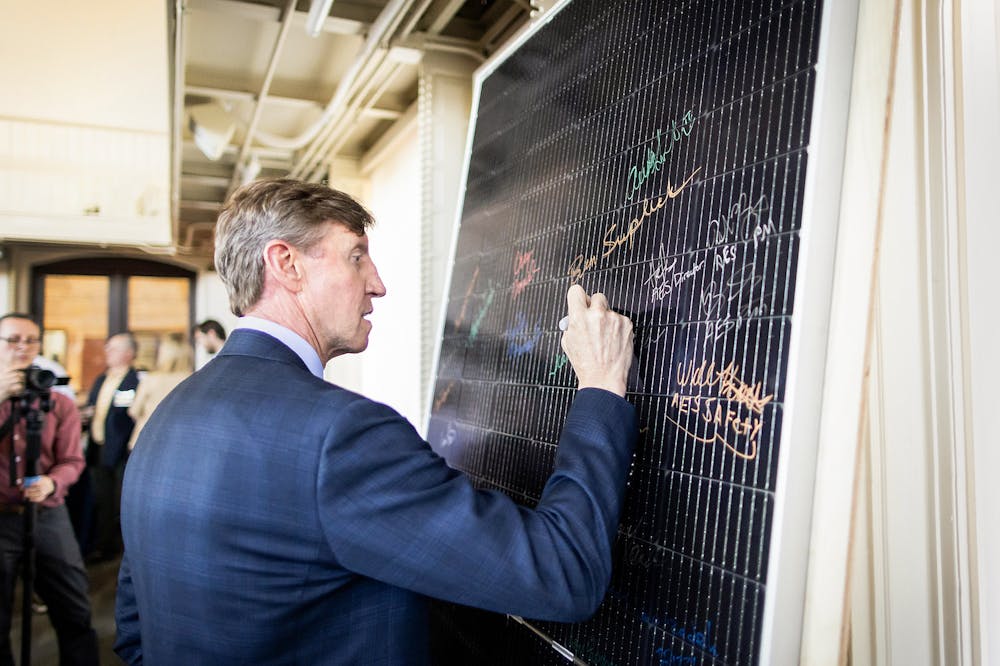Penn will be purchasing all electricity produced at two new solar facilities in Franklin and Fulton counties, with the goal of advancing Penn's commitment to achieving 100% carbon neutrality by 2042.
The Great Cove I and II facilities are part of the largest solar power project in Pennsylvania, comprising 485,000 solar panels with a capacity of 220 megawatts. Penn recently celebrated the solar production of the facilities, which became operational in December 2023, as part of Energy Week in March.
The solar project emerges from a partnership with Virginia-based energy company The AES Corporation. The facilities are expected to release 400,000 megawatt hours of electricity annually, In 2007, before the project’s launch, former Penn President Amy Gutmann signed the American College and University Presidents’ Climate Commitment to jumpstart sustainable efforts across campus.
Later that year, the University created the Environmental Sustainability Advisory Committee to help initiate the release of Penn’s first climate action plan in 2009. The University is currently operating under the climate and sustainability action plan 3.0.
In February 2020, Penn entered a Power Purchase Agreement with AES, and construction of Great Cove I and II solar facilities began in April 2022.
William Braham, professor of architecture and co-chair of ESAC, worked to help expand the University’s involvement in solar development projects across the state. He said that he advocated for the committee to focus on reforming the University’s power supply rather than continuing their investment in city buildings.
“If you put solar panels on every roof and every kind of surface you can find on campus, it would produce 2% of the power the campus uses,” Braham said. “The farms are 1600 acres compared to one to two hundred acres on campus.”
Penn acquires the energy from the solar facilities by paying AES for the electricity generated at the sites. Following this initial transaction, the energy is then sold to the regional electricity company PJM.
RELATED:
Former Penn employee sues Gene Therapy Program director, alleging 'unethical and illegal conduct'
Wellness at Penn, MERT host Narcan administration training event
“Every unit of renewable energy produced is kept track of very carefully and regulated by the state and utilities,” Braham said. “You make the choice to keep the retiring credits, offsetting the power Penn consumes on its campus."
Faramarz Vakili, executive director of operations and maintenance in Penn’s Facilities and Real Estate Services, manages electricity production and utility-related matters on the solar farms. Vakili highlighted the common misconception that electrons produced on the farm are the same electrical units used to power buildings across campus.
“The electrons produced on the farm are not the electrons lighting the lightbulbs in the dorm room,” Vakili said. “You buy the electrons from the developer and then it is sold on the market for market price.”
Beyond their purpose as a source of clean energy, the solar facilities offer cultivable land for sustainable crop growth. Hannah Winn, a master’s student at the College of Liberal and Professional Studies and the College of Arts and Sciences, used the project as inspiration for her capstone project on environmental studies. Winn maintains the soil on the land to ensure that it will be ready to host crops by the time that Penn’s contract with the solar facilities expires.
“I took a bunch of soil samples to run against the soil samples that were taken by the company who did the pre-construction installation, and we will continue to do that over the next several years,” Winn said. “This land has been in farmers' families for generations, so it is crucial to maintain the soil that we are building on.”
Referencing Penn’s goal to be 100% carbon neutral by 2042, Vakili noted the University’s ongoing efforts to harness more forms of alternative electricity. However, he said that to make a long-lasting impact, Penn will have to implement policies on a larger scale.
“We can first start by improving the efficiency of energy in buildings as well as taking this into consideration when building new buildings,” Vakili said. “[We hope to] educate the users, students, faculty, and staff on the best practices to conserve energy in order to not waste it.”









